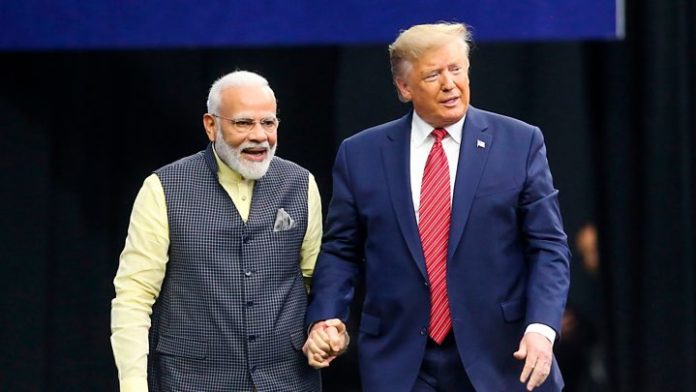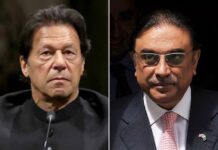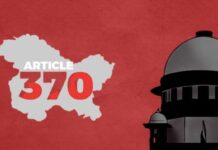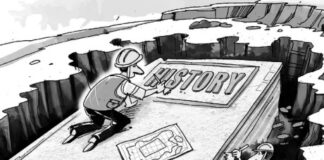The US is well aware of India’s importance in its foreign policy. One would hope that President Trump would use the occasion to deepen the relationship further and not let the partnership be derailed by making specific trade issues as the touchstone of success. Trade cannot be the only driver of Indo-US relations.
By Arvind Gupta
President Trump is visiting India on a state visit on 24-25 February 2020. The Indian government will no doubt lay out the red carpet for the visiting President. This is President Trump’s first visit to India as President. Although the visit comes late in his presidency, Prime Minister Modi can take credit for securing Trump’s visit. A massive public reception, which in scale and grandeur will match the “Howdy Modi” show in Texas, awaits the president when he visits Gujarat. The expectation in India is that the visit would lead to further cementing of strategic relations between the two countries. At the same time, given President Trump’s unpredictable nature, there are anxieties how the visit may pan out.
While visiting India, Trump would be in a celebratory and triumphant mood. After having been impeached by the Congress, he has been acquitted by the Senate. The Democrats are in a disarray. The American economy is doing well, creating jobs. Trump would be confident about the prospects of his winning a second term as President.
On the foreign policy front, Trump has humbled China. The China-US phase one trade deal is almost entirely one-sided, in favour of the United States. China is grappling with the coronavirus outbreak which has raised concerns about Xi’s leadership. The Chinese economy is in trouble. There are question marks about social and political stability in the country.
A confident Trump has unveiled his Middle East plan which is weighted in favour of Israel and has been rejected by the Palestinians entirely. President Trump can draw comfort from the fact that the leading Gulf countries are ambivalent about the plan.
President Trump’s visit takes place at a time when the BJP has lost four State elections in a row after winning the general elections handsomely in May 2019. Indian economy is in a slowdown. In the US there has been criticism of the way the Indian government is handling the J&K situation. The Western media has been hostile to the government on the Citizenship Amendment Act (CAA) issue. Although, India’s senior officials have been in touch with their counterparts in the US on these issues, how Trump reacts publicly during his visit remains uncertain. On Jammu and Kashmir, President Trump has publicly offered mediation between India and Pakistan, something which India has rejected. Therefore, what unpredictable Mr Trump might say on Jammu and Kashmir, would be a matter of anxiety for the hosts.
Trump in the past has not hidden his displeasure at the adverse balance of trade between India and the US. He has described India as ‘tariff king’. The fact is that India-US trade merchandise and services have reached $140 billion and growing. The adverse balance of trade in merchandise trade is only to the tune of about $ 16 billion in 2018-19 which is not that big. US exports to India are growing. Yet, the US has slapped tariffs on some Indian steel and aluminium products and withdrawn the Generalised System of Preferences (GSP). Since then, the two sides have been engaged in intense negotiations to sort out the differences and arrive at an acceptable trade deal. It would be nice if a trade deal is signed during Trump’s visit so that the contentious issues are resolved. However, the US side has been bargaining hard. They have been seeking greater market access for their dairy products, medical devices and IT companies and also are unhappy on India’s data localisation policies. It is up to the US not to let trade be a deal-breaker. In fact, it will be in US interest to accept what is on offer from the Indian side, which is quite substantial.
Defence cooperation is emerging as one of the most promising pillars of Indo-US relations. The second 2+2 dialogue held last year has been positive. With Logistics Exchange Memorandum of Agreement (LEMOA) and Communications Compatibility and Security Agreement (COMCASA) having been signed, the two sides are now discussing another foundational agreement called Basic Exchange and Cooperation Agreement (BECA). The Industrial Security Annexe (ISA) has also been concluded. This will open the way for more US defence exports to India and also help Indian manufacturers to supply equipment to US companies by coming into their global supply chains. The government is keen to buy more high-tech equipment and weapons from the US. India has already bought $ 18 billion of equipment and weapons in the last 10 years. This should please the US side. The two sides have also been taking steps to institutionalise the Defence Technology and Trade Initiative (DTTI). New mechanisms like to DTTI Standards Operating Procedure and DTTI Industry Forum have been set up. This will bring the Indian private industry into DTTI discourse. It remains, however, to be seen to what extent the US companies will actually transfer cutting-edge technologies to India.
India has been buying crude oil from the US for the last couple of years. This is a game-changing development. Although still small, the US oil exports to India are likely to increase in future as India has stopped buying oil from Iran. Growing purchases of oil have also reduced the balance of trade. Last year India bought about 2 million tonnes of oil from the US. Energy cooperation seems to be a promising area in Indo-US relations.
On Iran, the US has shown an understanding of the Chabahar port construction as it helps stabilise Afghanistan. This was evident in the joint statement issued after the last ‘2+2’ meeting. But the US position of Iran will remain hard. India should ensure that US-Iran tensions do not go out of hand.
India has a large 4 million strong diaspora in the US. Nearly 200,000 Indian students in the US contribute about $ 6 billion to the US economy. Indian companies have invested $ 16 billion creating about 116000 jobs. From the Indian side, at H1B Visa’s is a major issue. But it cannot be a deal-breaker.
In the recent past, Indo-Russian relations have warmed up, particularly after Prime Minister Modi’s highly successful visit to Vladivostok, where he met President Putin and announced a $1 billion line of credit for Russia’s Far East. One hopes that the two sides will not allow Indo-Russian relations to become a stumbling block in the development of Indo-US relations. It is not clear whether the US will grant India a waiver from sanctions and let India purchase the Russian S-400 missile defence system.
Clinton, Bush and Obama have contributed to the foundation and growth of Indo-US strategic partnership. This has been mutually beneficial. Trump’s visit is an occasion to put in the Indo-US relations in the broader strategic context. It is unfortunate that the relationship seems to have got mired in smaller issues and prolonged and tortuous trade negotiations. While the nitty-gritty is important, the strategic context should not be missed out. The larger context involves the entire Indo-Pacific where China’s rise has changed the geopolitical equations considerably, to the disadvantage of both the US and India. India’s security on the western side is vulnerable. On the western side, India and US need to coordinate their positions much better, be it on Afghanistan or on the Middle East.
The US is trying hard to reach a deal with the Taliban. India has not been involved in these negotiations. Partly this is because India has refused to talk to the Taliban. Nevertheless, if the US and the Taliban reach a deal, it will have a major impact on the region and also on India. Hopefully, the US will keep in mind the Indian interests in the region while negotiating with the Taliban.
As two premier knowledge economies, India and the US can cooperate and collaborate on emerging technologies, which will shape the new world order. Artificial intelligence, 5G, cloud computing, machine learning, space technologies blue economy, clean energy, bioinformatics, pharmaceutical, agriculture, water etc. or some of the major areas for cooperation. The cooperation will yield big socio-economic benefits for both sides. We can also discuss the emerging nuclear order, space security and cybersecurity issues. Trump’s visit is an excellent opportunity to deepen collaboration in these areas.
In January this year, the U.S. Congress passed the resolution 4331 on Tibet Policy and Support. The Resolution has yet to be passed in the Senate before it goes to the President. It is a comprehensive resolution which promises sanctions against Chinese officials if they interfere in the process of selection of Dalai Lama’s successor. What happens in Tibet is of great importance to India. China has been laying claims on Arunachal Pradesh, regarding it as part of Tibet. This is clearly unacceptable to India. Likewise, China has made formal protests after the Article 370 amendment. During Trump’s visit, India could seek for a briefing at the highest levels as to how the US looks at the situation in Tibet. The two countries can also discuss the evolving situation in Xinjiang.
The US is well aware of India’s importance in its foreign policy. One would hope that President Trump would use the occasion to deepen the relationship further and not let the partnership be derailed by making specific trade issues as the touchstone of success. Trade cannot be the only driver of Indo-US relations.
In India, the assessment is that Trump is likely to win a second term as president. So Trump’s visit should be seen as an investment in the future of bilateral strategic partnership which has the backing across the political spectrum both in India and Pakistan.
The author is director VIF. This article was first published in VIF and belongs to them












